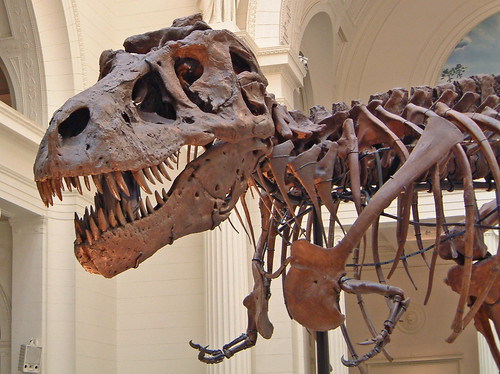
Paleontologists may have solved the mystery of how spinosaurs and tyrannosaurs--two dinosaur groups that included manylarge, fierce predators--could have lived in the same regions at the same time. A new study suggests that, like many pairs of surly neighbors, they simply avoided each other.
Spinosaurs, the sail-backed dinosaurs made famous by a star turn in the movie Jurassic Park III, belonged to a group of meat-eating dinosaurs called theropods. But unlike tyrannosaurs and most other theropods, spinosaurs had conical, unserrated teeth similar to those found in crocodiles, says Romain Amiot, a paleontologist at University of Lyon 1 in Villeurbanne, France, and coauthor of the new study. And although spinosaurs had long, crocodile-like snouts and fossilized stomach contents suggest their prey included fish, the creatures didn't have any skeletal features that hint at a semiaquatic lifestyle, such as feet specialized for swimming.
But the ratios of oxygen isotopes in the creatures' teeth tell a different story, Amiot and his colleagues report in the February Geology. Creatures that spend a lot of time in and around the water- like hippos and crocodiles--typically have lower oxygen-18 to oxygen-16 ratios in their bones and teeth than their landlubber counterparts.
In spinosaur teeth from 12 sites, including southeast Asia, north Africa, England and Brazil, the researchers found that average oxygen isotope ratios were substantially lower than those of tyrannosaurs or other theropods living in those regions at the same time. The isotope ratios were, however, similar to those of contemporaneous crocs and turtles, a sign that the spinosaurs probably spent much of their time in and around lakes and rivers.
[ILLUSTRATION OMITTED]
The new findings "solve the big ecological problem of how spinosaurs could live in the same areas as tyrannosaurs," Amiot says. "They were avoiding competition for food and territory by dividing up the ecosystem," he says.
Source Citation
Perkins, Sid. "To escape rivals, simply sail away: sail-backed dinos avoided T. rex by taking to the water." Science News 13 Mar. 2010: 18. Academic OneFile. Web. 6 Apr. 2010.
Document URL
http://find.galegroup.com/gps/infomark.do?&contentSet=IAC-Documents&type=retrieve&tabID=T003&prodId=IPS&docId=A222251720&source=gale&srcprod=AONE&userGroupName=broward29&version=1.0
Gale Document Number:A222251720



No comments:
Post a Comment